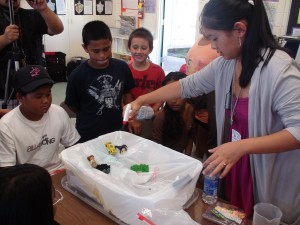Watershed Stewardship through Hands-on Exploration

Originally appears in the Spring 2011 issue
“Once individuals become aware of and interested in their watershed, they often become more involved in decision-making as well as hands-on protection and restoration efforts. Through such involvement, watershed approaches build a sense of community, help reduce conflicts, increase commitment to the actions necessary to meet environmental goals, and ultimately, improve the likelihood of success for environmental programs.” (EPA, 1996)
We all live in a watershed. Look right in your backyard, out at the school playground, or the parking lot at your local supermarket—no matter where you are, you are in a watershed. A watershed is a geographical area in which all water, both surface and groundwater, converges and drains into a common waterway (often a stream, lake or river) and eventually into the ocean. Watersheds link all living creatures through this common hydrologic system. Each watershed, large or small, is unique and defined by its own geology. The health of our watersheds affects the quality of our drinking water, the aesthetics of our recreation areas and the health of the plants and animals of our region.
Cultivating a climate of watershed stewardship in our classrooms begins with awareness, active inquiry and positive action. Elementary students are often taught about the water cycle, but the concept of a watershed is more complex. It includes a multifaceted framework that considers topography, flora, fauna, the human element and the dynamic interaction of this ecology. The watershed construct provides an ideal case study to explore systems thinking.
This content is restricted to subscribers only.
If you are not yet a subscriber, please consider taking out a subscription here.
If you are an existing subscriber, kindly log in or contact us at info@greenteacher.com for more information.










